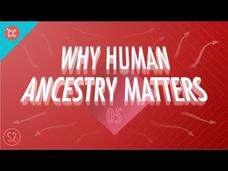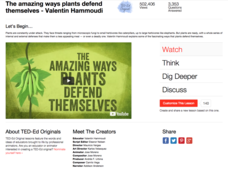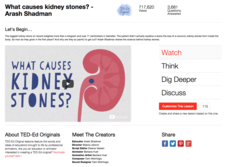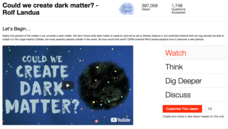PBS
The Search for the Earliest Life
Life existed on Earth more than four billion years ago, much earlier than scientists predicted. Eons presents a lively video as part of a larger series. It explains the recent findings on multiple continents that alter the timeline of...
PBS
A Brief History of Geologic Time
How do scientists know the history of Earth before humans—or any mammals—existed? An epic "Eons" series video explains the larger history of geologic time. It highlights the eons, eras, periods, epochs, and ages scientists use to divide...
Socratica
Chemistry: What Is a Metal? (Metallic Bonds)
Metals offer unique properties thanks to the structure of their valence electrons. The Socratica chemistry playlist includes this video explaining what a metal is and the properties of metals. It focuses on their structures, features,...
Crash Course
Why Star Stuff Matters: Crash Course Big History #202
Carbon makes all life on Earth possible, not to mention most technology and progress. The 12th video in a 16-part series explains the significance of being made of star stuff. From the formation of chemical elements to the rise in...
Crash Course
Why Human Ancestry Matters: Crash Course Big History #205
Genetic variation makes for stronger species, but for a mammalian species, humans are disturbingly closely related. Help your class explore human ancestry and genealogy using the 15th video in a 16-part series. It describes how we became...
Crash Course
Why Human Evolution Matters: Crash Course Big History #204
Is the progression of human complexity due to eating meat? The 14th video in a 16-part series attempts to answer this and other thought-provoking questions. It relates the process of human evolution and innovation to our ability to learn...
Crash Course
Migrations and Intensification: Crash Course Big History #7
What happens when the earth reaches its carrying capacity of humans? As human populations grow, societies change from hunters and gatherers to agriculture to the industrial age and beyond. A video takes a global perspective of migration...
Crash Course
Why the Evolutionary Epic Matters: Crash Course Big History #203
Imagine a world where the only animals roaming the earth are domesticated. One day, we might not have to imagine the scenario of no wild animals—and that day approaches faster than predicted. A video explains the evolution from...
Crash Course
The Sun and The Earth: Crash Course Big History #3
Amaze your class with the fact that more than 1,000 confirmed planets exist. The video explains the formation and development of planets, especially the earth. It covers the solar nebula, birth of the sun, and the development of the...
Crash Course
The Big Bang: Crash Course Big History #1
Theoretical physicists say that space and time are one thing created by the Big Bang. According to them, nothing happened in the time before the Big Bang because time did not exist. The first Crash Course-Big History video in a 16-part...
TED-Ed
Cell Membranes Are Way More Complicated Than You Think
Cell membranes contain many contradictions; for example, they are both oily and strong. The video explains the parts of a cell membrane, the function of each part, and discusses the contradictions. It highlights what happens when...
TED-Ed
The Amazing Ways Plants Defend Themselves
Plants can't run away from their predators, so they develop unique ways to defend themselves. The video presents many different defensive techniques that plants use. It also discusses how animals respond to these traits.
TED-Ed
How Ingenious Animals Have Engineered Air Conditioning
Humans aren't the only species to build structures with air conditioning—we weren't even the first! The video explains how a variety of species that live under and above ground design their structures to allow for air circulation. It...
TED-Ed
What Causes Kidney Stones?
Could you imagine having a kidney stone the size of a coconut? Viewers learn about the largest kidney stone ever recorded in a video that explains what kidney stones are and how they form. Then, it details multiple procedures to treat or...
TED-Ed
What is Entropy?
Entropy, often misunderstood yet easily proven through mathematics, caused confusion for many years. A video explains entropy through simple models. It demonstrates the mathematical proof behind the phenomenon.
TED-Ed
Plants Use An Internet Made of Fungus
If a tree is infected with bugs in a forest, can it warn the neighboring trees? Amazingly, this communication happens regularly. Scholars observe the phenomenon and learn how scientists discovered the way fungus works as a neural network...
TED-Ed
The Science of Smog
In 1952, a mysterious fog killed an estimated 4,000 people in London, raising awareness of the relationship between air quality and public health. An interesting video explains two different types of smog, describing the conditions...
TED-Ed
Could We Create Dark Matter?
Dark matter makes up 85 percent of our universe. The video explains current scientific research to create and better understand dark matter. The narrator explains the research into the large hadron collider with easily understandable...
TED-Ed
How to Squeeze Electricity Out of Crystals
It is possible to generate electricity by squeezing a single sugar crystal. A short video explains how this is possible and the way this knowledge has changed our society. From sonar devices to renewable energy, generations rely on this...
TED-Ed
Is There a Reproducibility Crisis in Science?
Less than 25 percent of published research proves reproducible. The video discusses the importance of duplicating results, introduces the challenge related to this task, and examines the issue from multiple points of view, allowing for...
Teacher's Pet
Probabilities, Dihybrid and Test Crosses
Epistasis originated from genetics but now applies to biochemistry, computational biology, and evolutionary biology. The video introduces epistasis as it relates to genetics. It also discusses dihybrid crosses, test crosses, polygenic...
Physics Girl
Calculating Pi with Darts
Can pi be calculated through a game of darts? The video shows why this works mathematically and the issues surrounding the methodology. Once participants overcome errors, success through physics and mathematics leads to celebration.
Physics Girl
Why is the Universe Flat?
British astronomer Sir Fred Hoyle first coined the term the Big Bang in 1950. The theory explains much of what we have observed in the universe, but it does leave some things unexplained. The video discusses the Cosmic Inflation...
Bozeman Science
Drawing Lewis Dot Diagrams
Viewers get a step-by-step explanation for drawing Lewis Dot Diagrams with a video that includes numerous examples of atoms, simple molecules, and how to represent covalent bonds.























